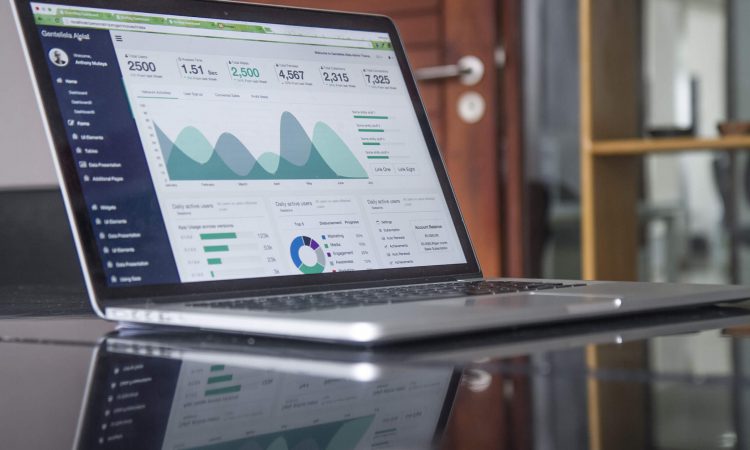
What do you have in common with a supercomputer?
Probably more than you think. After all, the functioning of the brain is, at its core, very similar to that of a computer: it takes data, analyzes it, and then… makes decisions.
Artificial intelligence is nothing more than an attempt to reproduce the functioning of the human brain, but without its limitations and weaknesses. That is to say, with more memory, greater processing capacity, and the absence of errors and cognitive biases —quite a lot— 🙃
And business intelligence has a lot to do with that whole process, as it is responsible for obtaining that data and turning it into information in order to make the right decisions… and, of course, to generate more sales.
A computer system may have less charm than us, but it must be acknowledged that it has a “little advantage” over us when it comes to handling and analyzing data.
Therefore, its logical decisions are much more reliable than ours —which can be very useful when managing a business—.
Do you want to know more about how you can make better business decisions thanks to business intelligence? Keep reading, and we’ll tell you all about it.
What is business intelligence?
Business intelligence, or Business Intelligence (BI), consists of transforming the data that a company obtains from its management system, daily documentation, or external sources into information.
For example, your CRM holds a lot of data about your products, sales, and customers, but if you don’t analyze them to extract information that can be applied to make better decisions for your company, they won’t be of much use to you.
Imagine that you market a SaaS for accounting management, offering two possible plans: Basic and Premium. The first is aimed at freelancers and small businesses, while the Premium plan targets companies with 250 employees or more.
Generally, large companies are delighted with the features of the Premium plan. However, you notice that there are customers in the first group for whom the Basic plan falls short. So, you decide to create a Medium plan that better suits this buyer persona profile.
You put a lot of effort into promoting it through free demos among current customers who you think might be interested. Additionally, you design a specific sales funnel for this plan through the Internet.
However, the expected results don’t come. Everything seems fine, but the sales from the leads generated through the sales funnel don’t quite materialize. They reach the demo, try it out, but… at the end of the free trial period, they don’t make a purchase.
A business intelligence tool could provide a possible answer by cross-referencing data from your CRM and your communication channels—social media, chatbot, customer support, etc.
Through online comments and reviews, for example, you could find out if users found the tool useful or easy to use.
If you observe that many leads who didn’t end up buying mention that they find it non-intuitive, while existing customers navigate it smoothly, the problem may lie in a learning curve that is too long for someone unfamiliar with the tool or for this specific type of customer.
In that case, you could consider offering support services or training for new customers to eliminate that barrier and close more sales for your new plan. Something you wouldn’t have been able to do without understanding the root of the problem.
Having the right information allows you to make better decisions for your company. Hence, the importance of business intelligence 😉 But are marketing and sales the only applications of Business Intelligence? Absolutely not, and in the next point, we’ll explain where else you can apply it in your business.
Applications of business intelligence
Business intelligence can be applied to any area of your company. It’s all about cross-referencing data from different sources, and you decide which sources you want to leverage. Here are the most common areas where you can apply business intelligence:
- Production: If your business involves physical manufacturing, data from your production line—machinery, maintenance, labor performance—can help you improve your processes and enhance production.
- Logistics: Lack of control over product shipments can lead to problems with your customers. Having comprehensive information related to logistics will help you improve your deliveries and customer service.
- Finance: Your finance department generates a vast amount of data—expense and revenue lines, invoicing, taxes, etc. Obtaining reports that allow you to view all this data in context will provide valuable insights to optimize costs and make better forecasts.
- Marketing: Knowing what’s happening on social media and understanding what works and what doesn’t in your marketing campaigns will save you time and money. It will enable you to enhance your customer knowledge, improve lead nurturing processes, and utilize more effective marketing techniques.
- Sales: By analyzing data from your CRM, you can understand your customers’ behavior, identify which products perform best, and determine which ones are most profitable for you. Are small recurring customers more profitable than large occasional ones? Does offering product promotions bring you more benefits? Business intelligence will help you find answers to these questions.
By now, you can already grasp what business intelligence can do for your company. However, let’s delve a bit deeper to ensure you don’t miss any of its benefits.
Advantages and Benefits of Business Intelligence
As we have just seen, business intelligence solutions are applicable to all areas of your company. This is crucial because your business functions as a cohesive whole. For example, the actions of your marketing department will influence sales, which, in turn, affect production or customer service.
Cross-referencing data throughout the entire process allows you to identify opportunities, areas for improvement, and most importantly, take action to enhance your results.
What are the benefits of business intelligence?
- Improved efficiency: Having a holistic view of the company enables you to optimize processes and overall operations. It’s pointless to generate numerous leads for your SaaS if you don’t realize that your sales department lacks sufficient resources to handle them, for instance.
- Deeper analysis: Analyzing data from both internal and external sources—CRM, social media, demographic or seasonal data—provides more precise information. For example, you not only know if your software sells more or less, but also which types of customers buy it—and which don’t—when they make purchases, what they say about it, and at what stage of their customer journey they were in when they did so.
- Ease of forecasting and problem-solving: Business intelligence not only offers information about the past and present but also enables predictions, anticipating problems, and designing more effective strategies. If you know that your sales always increase at the beginning of the year, you can better prepare your campaigns and hire additional staff to prevent missed opportunities, for example.
- Enhanced internal knowledge management: All the information obtained is stored in a centralized and accessible database, allowing for easy consultation whenever necessary and enabling quick and efficient decision-making.
- Improved customer service: The database generated through business intelligence centralizes all your business information and remains consistently updated. This facilitates online and telephone customer support and simplifies the implementation of a multichannel or omnichannel customer service strategy.
The advantages of business intelligence are numerous but would not be possible without a complex technological system that provides the right information. How does a business intelligence system work? Keep reading, and we’ll explain it to you.
Elements in business intelligence systems
Now let’s get into the technical part: what elements constitute a business intelligence system?
Business intelligence is a complex system in which data undergoes a journey from collection in various sources to being displayed, once analyzed, on a visualization screen that enables better decision-making for the business. Let’s discuss the elements of business intelligence and what each of them contributes to the overall decision-making process.
Data Sources
As the name suggests, data sources are the origins of the data that your business intelligence system will analyze to obtain relevant information for your business.
These data can already exist within your company, such as in software or departmental databases, CRM, or ERP. They can also come from external sources, such as social media or publicly accessible documents like government data or statistics. For example, one of your customer data sources could be your accounting SaaS, from which you can extract information about their income, expenses, or suppliers.
The first step in implementing your business intelligence system is determining the data sources from which you want to obtain information.
Extract, Transform, and Load (ETL) Processes
Do ETL processes analyze data? No, ETL processes extract data from data sources, transform it into a standardized format that can be related to each other, and finally load it into a Data Warehouse, where the analysis will take place.
For example, if you want to cross-reference data from social media with your CRM to detect patterns between lead behavior and sales campaign results, ETL processes have connectors to unify data from social media and various types of databases. With these processes, you can integrate information obtained about your leads on social media and customer behavior in your CRM into a compatible database. And then, it’s time for analysis.
Data Warehouse
The Data Warehouse is the database where all the data ends up after going through the ETL processes.
For example, data about potential customers from social media coexists with thousands of other data points obtained from your CRM, ready to be combined through data analysis to provide the insights you seek regarding your sales campaign.
Did those who entered your funnel via LinkedIn ads convert better than those from Facebook? How many of them ended up purchasing your SaaS? Did they share a common demographic profile? What type of companies did they belong to? The possibilities are endless; the key to good analysis lies in asking the right questions to obtain the answers you need, and that’s what you should do through OLAP.
Online Analytical Processing (OLAP)
Asking the right questions is not an easy task; your Data Warehouse contains thousands of isolated data points that, on their own, do not provide any relevant information.
However, each data point is a piece of the puzzle in the larger picture you want to achieve in order to answer your question. They need to be organized and combined to “tell” you something.
OLAP cubes are like the box where you store all the puzzle pieces. The answers are there, and correctly organizing, adding, and grouping the data they contain is the way to find them.
However, you will need the expertise of an analyst who knows how to do this, as OLAP is a complex tool and challenging to handle for someone unfamiliar with it. Once the analyst does their work, you can consult the reports in the visualization tools of your business intelligence system.
Visualization Tools
It’s time to visualize the results of the analysis. And not just any visualization, but a simple and interactive one through a dashboard that displays visual information such as charts and diagrams based on established Key Performance Indicators (KPIs).
You determine the information you want your dashboard to provide. For the example we were using, it could display charts about your marketing actions, sales, or market trends, to name a few possibilities.
If you want more detailed information about the performance of your social media advertising campaigns, for example, you could find it by entering the marketing actions chart. From there, you could delve into the impressions of your ads on each platform and access increasingly detailed information about your campaigns. These are the different elements that form any business intelligence system. Would you like to know about some business intelligence tools? In the following section, we provide a list of the most important ones.
4 Business Intelligence Tools for Your Company
Business intelligence is increasingly being applied in the business world, and as a result, the range of Business Intelligence tools continues to expand.
Here’s a brief overview of some of the most notable tools to make it easier for you to choose.
#1 Tableau
Tableau is one of the most highly regarded business intelligence tools, and it also has its own CRM.
One of its most interesting features is its seamless integration with data from commonly used sources in companies, such as Excel, Google Analytics, Oracle, or MS SQL.
For example, it can extract data from spreadsheets in your finance department and cross-reference them with your website analytics to draw conclusions about the relationship between website visits and your business results.
#2 Microsoft Power BI
Microsoft Power BI is a cloud-based Business Intelligence tool, allowing you to use it from anywhere as long as you have an internet-connected device.
It analyzes data from all areas of your business and presents it in a visual and interactive manner through a user-friendly interface. Creating your own reports and extracting the specific information you need to make better decisions for your business is a breeze. Of course, if you work with Microsoft applications, you won’t have any issues integrating them with Microsoft Power BI, but it can also be used with other software.
#3 SAS Business Intelligence
One of the standout features of SAS Business Intelligence is its advanced predictive analytics capabilities.
Through Big Data, it can use data collected from all your sources to make predictions about the future.
By cross-referencing and analyzing information from your system, it could provide insights into customer behavior, for example, which would be valuable when designing sales strategies like the launch of the Medium plan for your SaaS.
#4 MicroStrategy
MicroStrategy is a cloud-based Business Intelligence tool that allows you to access information from anywhere.
In fact, their mobile application was one of the first in the industry, and they have continued to enhance its capabilities in this format.
It can easily integrate with almost all applications, data systems, and your Microsoft Office files.
The drawback is that its usability is less intuitive compared to other platforms, so the learning curve may be longer.
These are just a few of the Business Intelligence tools available on the market, and we won’t go into further detail in this guide to stay on topic. However, if you want more information, we have a dedicated post on business intelligence tools that will surely help you improve decision-making in your business.
Now that you know what business intelligence is and how it works to obtain valuable information, let’s dive into how AI uses it for what truly matters to you: making decisions that lead to more sales closures.
How AI Helps Make Better Business Decisions
We mentioned earlier that AI “replicates” the functioning of the human brain—and does it well. It can handle large volumes of information and learn from it to obtain reliable insights for decision-making.
How can AI leverage these capabilities to help improve business decision-making?
Analyzing Customer Sentiments
A skilled salesperson can read a customer and adapt their message to increase sales opportunities. However, no matter how much experience they have, they will never have as much information as an artificial intelligence system. AI in sales can analyze customer emotions through conversations with your teams. Moreover, it learns from each individual and can predict their behavior based on that.
Providing Better Product Recommendations
Understanding customers and their needs is crucial for delivering excellent service and offering the products or services that best fit their situation. The application of AI in commerce allows for deeper customer knowledge. This enables highly personalized customer experiences and more accurate product recommendations to achieve higher sales.
Predictive Prospect Scoring
AI also helps with lead scoring in your business by assessing the readiness of a prospect to make a purchase. Incorporating AI into a CRM is particularly valuable for focusing your sales efforts on prospects with a higher probability of successful conversions. By analyzing the percentage of closed deals based on their scoring, AI can extract new insights to improve future predictions.
Sales Forecasting
Sales forecasting is one of the most common applications of CRM. Accurate forecasts require data for analysis, and this is where AI shines. Its data handling and analysis capabilities enable more reliable predictions, empowering you to make informed decisions when designing your sales strategies.
Reducing Churn Rate
Bad news: sometimes your customers will churn. 😢
The “good” news is that your AI system will be on the lookout whenever this happens and will cross-reference information from each churn case to identify patterns that help identify the cause. This allows you to address the problem and avoid losing more customers for the same reason.
By now, it should be clear that AI is a powerful tool for improving decision-making in your business—and, of course, increasing sales. We won’t overwhelm you with more benefits of AI as you’re already aware of its many advantages. 😉 However, we do want to explain how we can assist you with our own AI-powered Business Intelligence tool to make better business decisions and close more sales. Shall we continue?
Upbe: Your Conversational AI Business Intelligence Tool
How much is at stake in each of your sales team’s calls? Considering that they are the final step in the sales cycle, everything is on the line. It’s either a sale or no sale.
In the case of B2B sales, the amount you lose with each lost deal can be considerable—plus the resources you’ve invested in that lead throughout the entire funnel.
That’s why it’s important to make it easy for your agents—and you’ve seen how much a Business Intelligence system can simplify their lives, haven’t you? 😉
Upbe is a conversational AI software that uses business intelligence to analyze data and provide valuable information to your agents to make better decisions during their calls.
They will have access to all the information extracted from analyzing customer data, and they will know the emotions of each customer in real-time.
Upbe will be there to inform them and help them steer the conversation efficiently, determining the best time to close the sale.
But what about team managers? Are there any advantages for them?
On the contrary, we saved something particularly interesting for that role. Team managers will be constantly informed about what’s happening in their sales team’s calls.
Real-time, reliable information to make the best decisions for your campaigns and to train the team for better results. 🤩
Information is power, and with Upbe, you have all the information you need to put the final touch on your sales processes. 👉 Do you want to give your sales team the superpower of information in your campaigns? Request your free demo and start improving your decision-making for more closed deals.





1 Comment
Comments are closed.